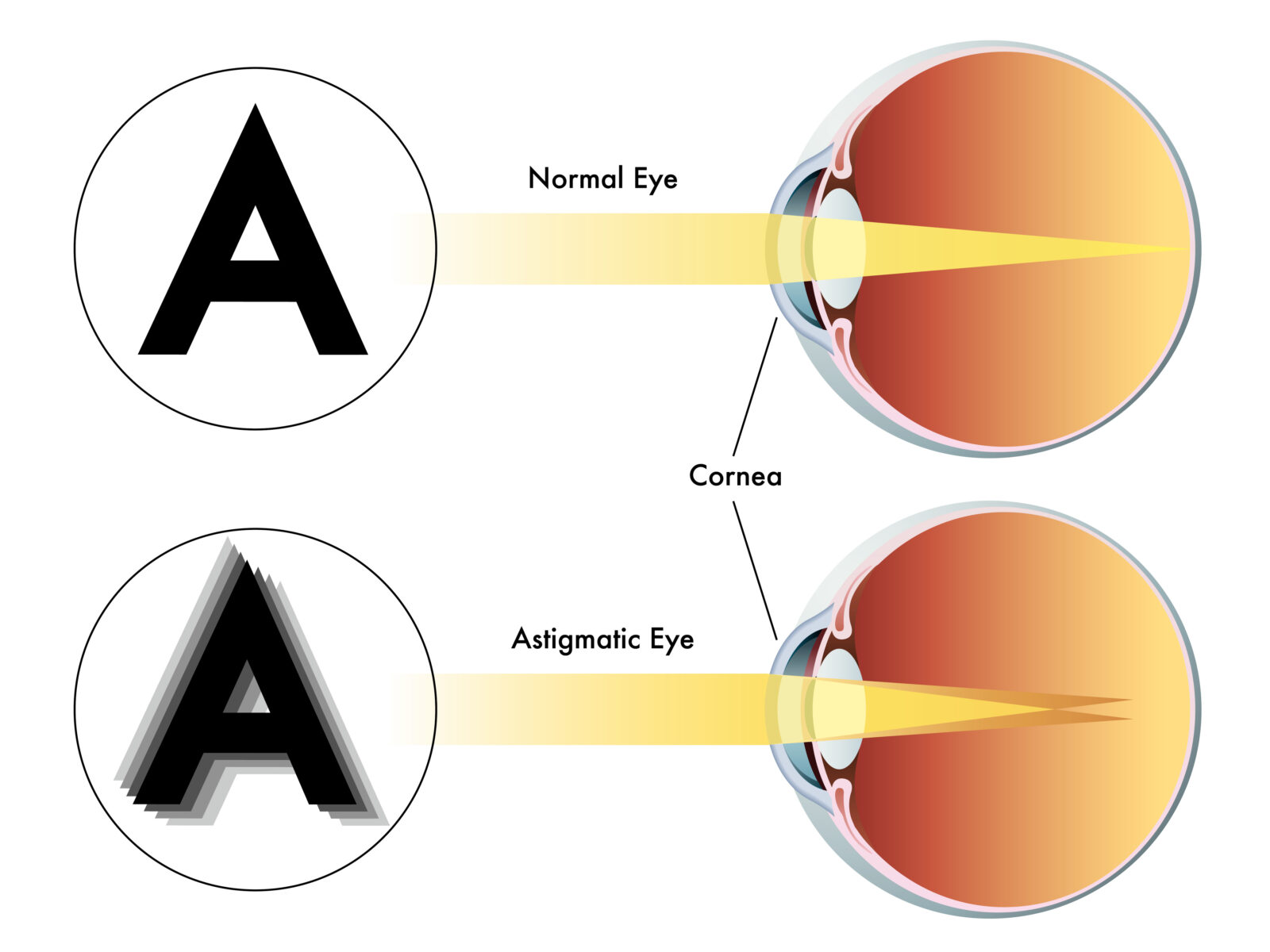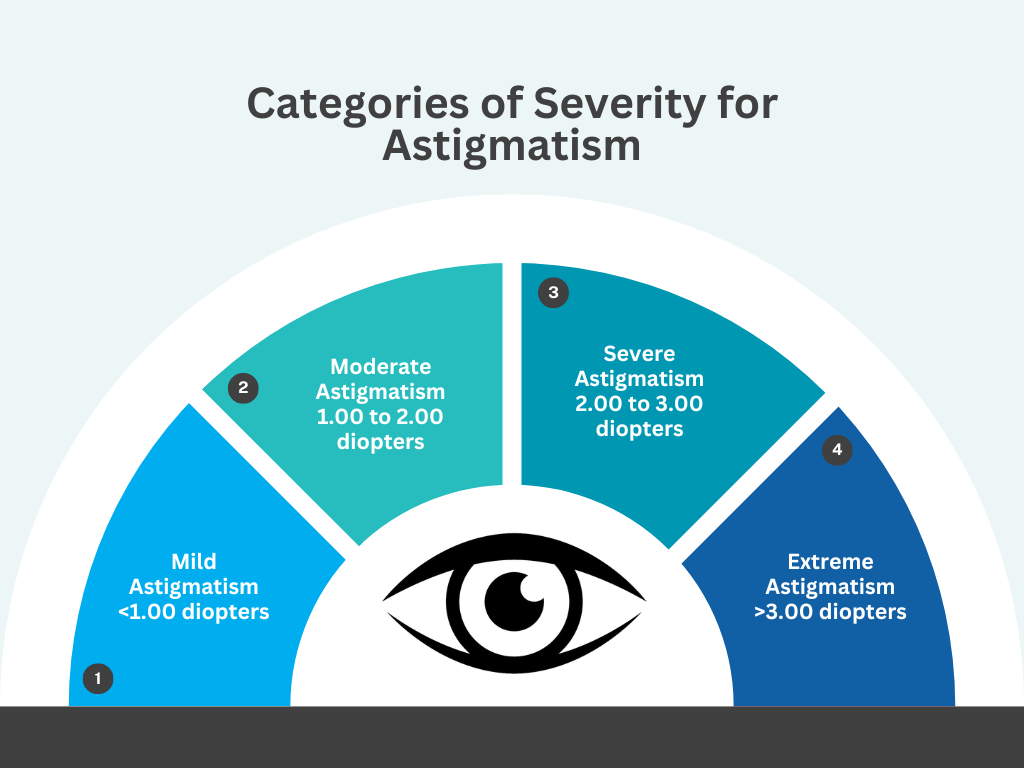What is Astigmatism?
Astigmatism occurs when your cornea is shaped like an egg. With astigmatism, more than one focal point within the eye distorts what you see. As a result, you experience a tilting of images due to the unequal bending of light rays entering your eyes.
Many patients with myopia and hyperopia have some degree of astigmatism, or an oval shape, to their cornea. People with high degrees of astigmatism have blurred vision for both near and distant objects.
Dr. Louis Probst treats in TLC Laser Eye Centers in Madison, Milwaukee, and Westchester (Chicago)
Normal Vision:
Good vision depends on light rays being precisely focused on the retina at the back of the eye. The optical system, comprised of the cornea, crystalline lens, and vitreous body, refracts or bends light so it lands directly on the macula – the point of best vision on the retina. This refraction, measured in diopters (D), involves the different parts of the optical system working together. Zero diopters means light focuses right on the retina, allowing sharp images. Any deviation from zero diopters indicates a need for vision correction to sharpen the view.

Astigmatism:
Astigmatism Causes Blurred Vision When the Cornea Has an Irregular Shape
Typically, the cornea has a smoothly curved, spherical shape like a ball. With astigmatism, the cornea is more irregularly shaped, resembling an egg. This causes light to focus at multiple points in front and behind the retina rather than one sharp focus on the retina. The uneven corneal curvature refracts or bends light differently based on the direction – vertical versus horizontal rays. The resulting distorted image may make a dot look like a line.
Exploring Treatment Options, Including LASIK Surgery
For those seeking a more permanent solution to astigmatism, laser eye surgery offers an effective alternative. Laser procedures are designed to reshape the cornea, correcting the irregularities that cause astigmatism and potentially reducing or eliminating the need for corrective lenses. However, not everyone qualifies, and the exact corneal shape is a crucial factor. Consultation with a laser surgery expert is essential to determine the suitability of LASIK surgery and explore other treatment options.
Types of Laser Eye Surgery for Astigmatism
LASIK for Astigmatism
LASIK (Laser-Assisted In Situ Keratomileusis) is one of the most popular and widely performed laser eye surgeries for correcting astigmatism. This procedure involves two main steps:
- Creation of Flap: A thin flap is created on the surface of the cornea using a precision instrument called a microkeratome or a femtosecond laser.
- Reshaping of Cornea: The underlying corneal tissue is then reshaped using an excimer laser to correct the curvature and thickness, allowing light to focus correctly on the retina.
LASIK is known for its rapid recovery time and high success rates, making it a preferred choice for many patients seeking vision correction.
PRK (Photorefractive Keratectomy) for Astigmatism
PRK is another type of laser eye surgery that can effectively treat astigmatism. Unlike LASIK, PRK does not involve creating a corneal flap. Instead, the outer layer of the cornea (epithelium) is gently removed to expose the underlying tissue, which is then reshaped with an excimer laser. The epithelium naturally regenerates over several days following surgery.
PRK may be recommended for patients with thinner corneas or those involved in activities that increase the risk of flap complications.
Benefits of Laser Eye Surgery for Astigmatism
- Permanent Solution: Laser eye surgery typically provides long-lasting results, reducing or eliminating dependence on glasses or contact lenses.
- Quick Recovery: Most patients experience improved vision within a few days after surgery, with minimal discomfort during the healing process.
- Customized Treatment: Each laser eye surgery procedure is tailored to the unique characteristics of your eyes, ensuring precise correction of astigmatism.
Is Laser Eye Surgery Right for You?
Determining the best treatment for astigmatism requires a comprehensive evaluation by an experienced laser eye surgery professional. Factors such as the severity of your astigmatism, corneal thickness, and overall eye health will be considered to determine your candidacy for LASIK, PRK, or other refractive procedures.
Consultation and Evaluation Process
When you visit [Our Clinic Name] for a consultation, our skilled ophthalmologists will conduct a series of tests and measurements, including:
- Comprehensive Eye Exam: Evaluating your current vision prescription and overall eye health.
- Corneal Topography: Mapping the curvature and thickness of your corneas to assess their suitability for surgery.
- Discussion of Options: Our team will discuss the benefits, risks, and expected outcomes of laser eye surgery, ensuring you have all the information needed to make an informed decision.
Types of Astigmatism and Their Impact on Vision
Astigmatism often coexists with farsighted or nearsighted vision, causing blurred vision and distortion. Nearsighted astigmatism focuses light in front of the retina, resulting in blurred distance vision. Farsighted astigmatism, on the other hand, causes light to focus behind the retina, making close-up objects appear blurry. Hyperopic astigmatism, myopic astigmatism, and mixed astigmatism are specific variations, each contributing to unique visual challenges.
- Hyperopic Astigmatism: Found in farsighted individuals with an astigmatic refractive error.
- Myopic Astigmatism: Affects nearsighted individuals with an astigmatic refractive error.
- Mixed Astigmatism: Occurs when an eye is both nearsighted and farsighted, causing blurriness at various distances.

Factors Increasing the Risk of Astigmatism
While astigmatism is common, certain factors increase the risk. Family history plays a significant role, and individuals with a genetic predisposition should inform their eye doctors. Additional risk factors include high prescriptions of myopia or hyperopia, maternal smoking during pregnancy, ethnic background, a history of eye surgery, and traumatic eye injuries.
Key risk factors:
- Family history
- High myopia or hyperopia prescriptions
- Maternal smoking during pregnancy
- Black or Hispanic ethnicity
- History of eye surgery
- Traumatic eye injury
Diagnosing Astigmatism Through Comprehensive Eye Exams
A thorough eye examination is crucial for diagnosing astigmatism. Tests such as visual acuity, refraction, and keratometry help determine the extent of astigmatism and guide treatment decisions.
- Visual Acuity Assessment: Measures the eye’s ability to discern details from a distance, often using a chart with letters.
- Refraction: Determines the refractive error, including astigmatism.
- Keratometry: Measures the curvature of the cornea, identifying irregularities associated with astigmatism.

Understanding the types of astigmatism, recognizing risk factors, and undergoing regular eye exams are vital steps toward maintaining clear vision. If considering LASIK surgery, consult with a qualified eye care professional to explore the best treatment options for your specific needs.
Source:
What Is Astigmatism? Symptoms, Causes, Diagnosis, Treatment. (2023, November 14). American Academy of Ophthalmology. https://www.aao.org/eye-health/diseases/what-is-astigmatism